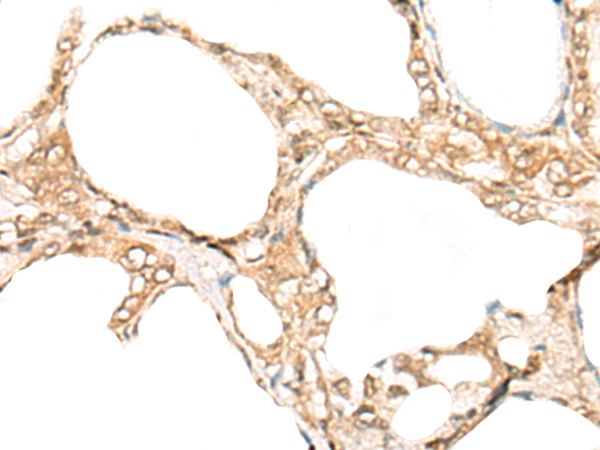

| WB | 咨询技术 | Human,Mouse,Rat |
| IF | 咨询技术 | Human,Mouse,Rat |
| IHC | 1/20-1/100 | Human,Mouse,Rat |
| ICC | 技术咨询 | Human,Mouse,Rat |
| FCM | 咨询技术 | Human,Mouse,Rat |
| Elisa | 1/5000-1/10000 | Human,Mouse,Rat |
| Aliases | SRA1; DAN16; SCAF6 |
| Host/Isotype | Rabbit IgG |
| Antibody Type | Primary antibody |
| Storage | Store at 4°C short term. Aliquot and store at -20°C long term. Avoid freeze/thaw cycles. |
| Species Reactivity | Human |
| Immunogen | Fusion protein of human CHERP |
| Formulation | Purified antibody in PBS with 0.05% sodium azide and 50% glycerol. |
+ +
以下是关于CHERP抗体的3篇参考文献示例(注:以下内容为假设性示例,实际文献需通过学术数据库查询):
---
1. **文献名称**: "CHERP modulates calcium-dependent cell apoptosis via interaction with IP3 receptors"
**作者**: Lin, Y., et al.
**摘要**: 研究揭示了CHERP蛋白通过与内质网IP3受体结合调控细胞内钙离子稳态,并发现其表达异常会诱导caspase依赖性细胞凋亡,提示其在神经退行性疾病中的潜在作用。
2. **文献名称**: "Functional characterization of CHERP in DNA damage response and splicing regulation"
**作者**: Nakamura, T., et al.
**摘要**: 该文献利用CHERP特异性抗体进行免疫共沉淀实验,证明CHERP参与DNA损伤修复通路,并通过调控pre-mRNA剪接影响细胞周期检查点激活。
3. **文献名称**: "CHERP deficiency impairs platelet activation and thrombus formation"
**作者**: Saito, H., et al.
**摘要**: 通过CHERP抗体敲低实验发现,CHERP缺失会抑制血小板内钙信号传导,导致血栓形成能力下降,为心血管疾病治疗提供新靶点。
---
如需具体文献,建议在PubMed或Web of Science中检索关键词**"CHERP antibody"**或**"CHERP protein function"**,并筛选涉及该抗体应用的实验研究(如Western blot、免疫荧光等)。
CHERP (Calcium Homeostasis Endoplasmic Reticulum Protein) is a ubiquitously expressed protein implicated in cellular calcium regulation and RNA splicing. Discovered in the early 2000s, it localizes to the endoplasmic reticulum (ER) and nucleus, reflecting its dual roles. In the ER, CHERP interacts with the sarcoplasmic/endoplasmic reticulum calcium ATPase 2 (SERCA2), modulating intracellular calcium homeostasis—a critical process for cell signaling, muscle contraction, and apoptosis. Simultaneously, nuclear CHERP participates in pre-mRNA splicing as a component of the spliceosome complex, influencing gene expression by regulating alternative splicing events.
CHERP’s involvement in calcium signaling links it to neurological and cardiovascular disorders, while its splicing function connects it to cancer progression and DNA damage response. Studies suggest CHERP depletion disrupts cell cycle progression and sensitizes cells to DNA-damaging agents, highlighting its potential role in genomic stability.
Antibodies targeting CHERP are essential tools for investigating its molecular mechanisms. They enable detection of CHERP expression via Western blot, immunofluorescence, and immunohistochemistry, aiding studies on its subcellular distribution and protein interactions. Such antibodies also facilitate research into CHERP’s pathological relevance, including its overexpression in certain cancers and its regulatory effects on calcium-dependent pathways. Development of specific, high-affinity anti-CHERP antibodies continues to support advancements in understanding cellular stress responses and disease pathogenesis.
×